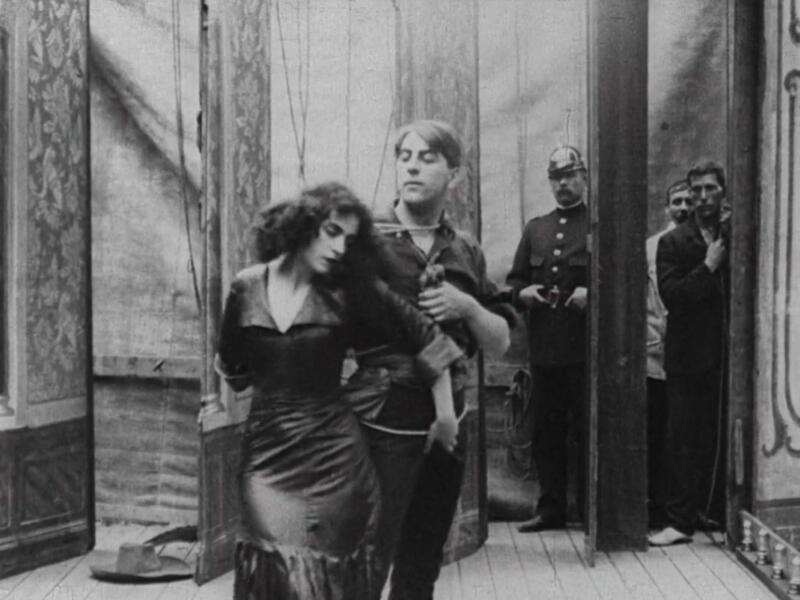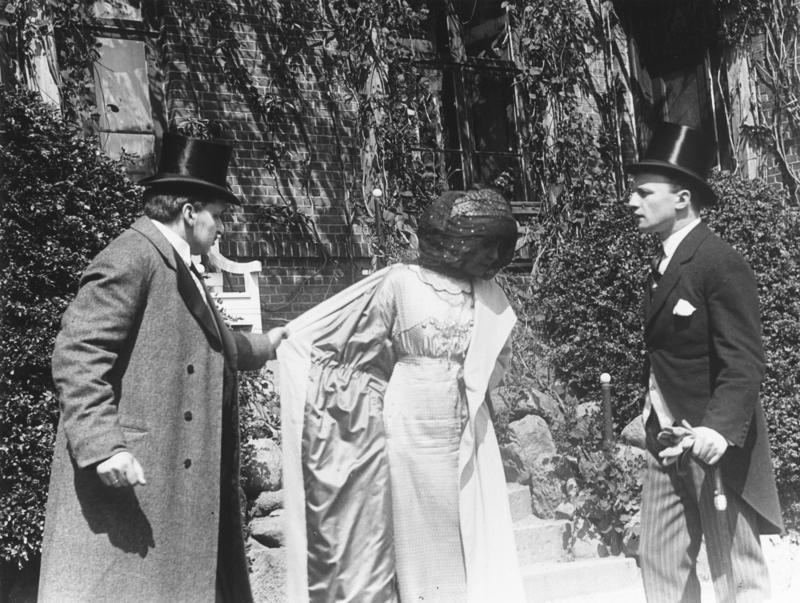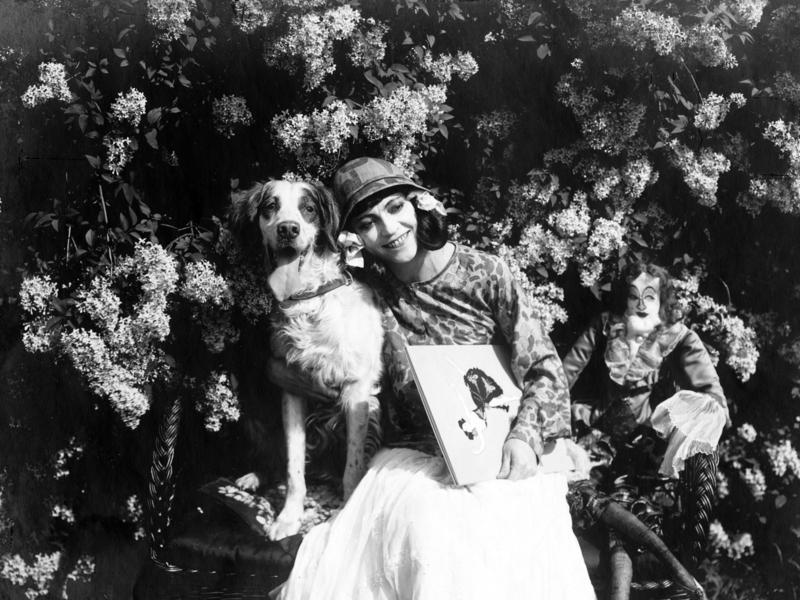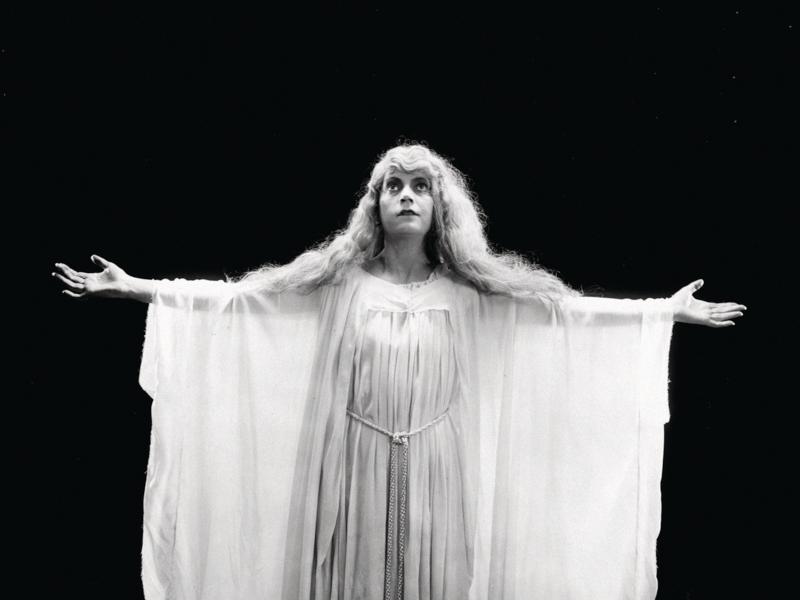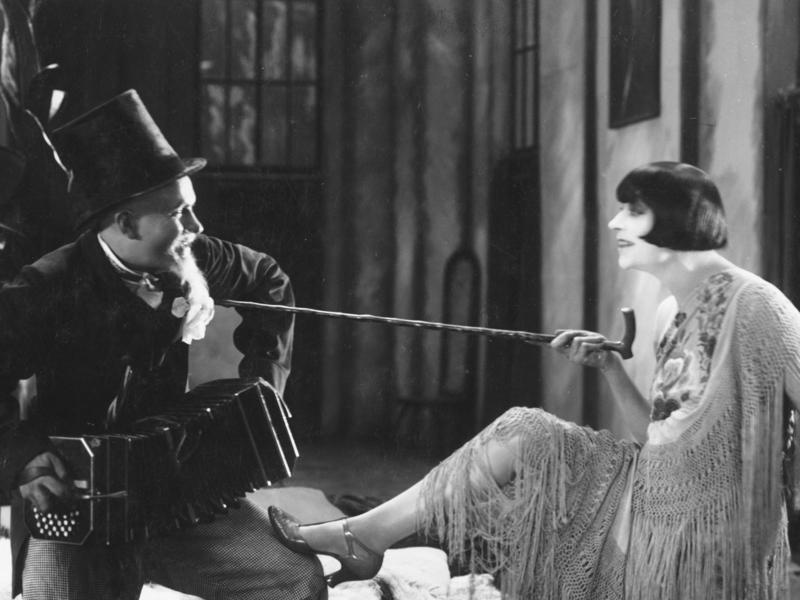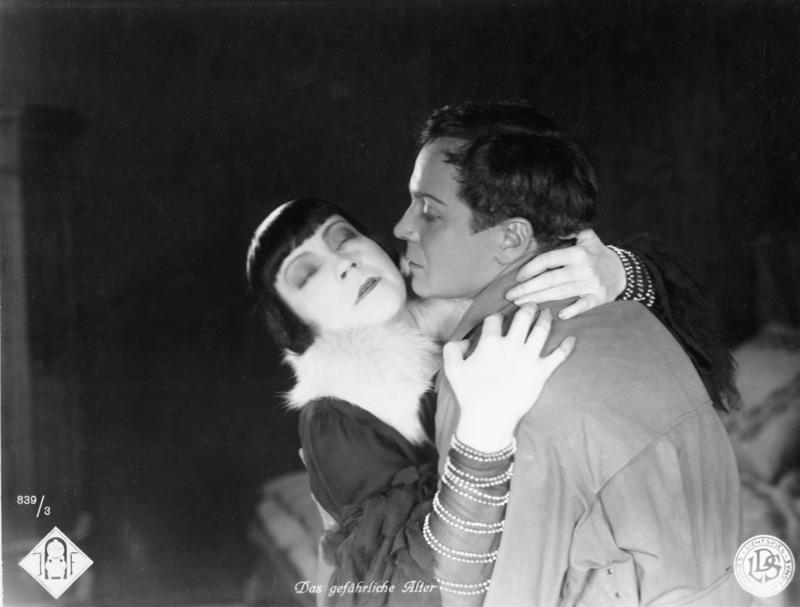Asta Nielsen – #BossLady
If Asta Nielsen had died only recently, we would be wearing t-shirts with her name emblazoned across our chests. We would sip our morning coffee from cups graced with her dark-rimmed staring eyes, feeling her look deep into our half-awake souls. The potent combination of a caffeine kick and her stern look would set us up to face the day with well-mannered discipline and steely resolve. We would be able to see her half-face appear as stencilled graffiti on a Nørrebro gable accompanied by the tagline ‘Asta – Queer as fuck’. We would wear badges bearing her photo and the hashtag #BossLady.
Nanna Frank Rasmussen, Cultural Journalist | 30 October 2020
We would pay such homage to the Danish actress in the hope that just a little of her aura would rub off on us. For some, it would be a low-key, perhaps even populist or commercially insincere gesture along the lines of ‘I’m a bit like Asta, too’. Others would stand up proudly to face the world with no fear, carrying the graven image of Asta on their clothes as a kind of spiritual spandex. If we carry Asta with us, we keep our fears down and our courage up.
Asta Nielsen was a megastar in her time and of her time. But she also has the potential to become a new icon for the present day. Not least because her life – as a myth and as a human being - is such an obvious signpost of the revolutionary potential of feminism. She herself was not a feminist in her words, but one could argue that she was a feminist in her deeds. In that sense, Asta Nielsen can be compared to other women who have only recently and suddenly become modern, feminist role models, such as the American Supreme Court judge Ruth Bader Ginsburg, or the French film director Agnès Varda. They were both well into their golden years before seeing a boost in popularity as younger women began to idolise them and their accomplishments. They became role models, hailed and celebrated late in life in a way they had never been before – and indeed it might not have been possible before because the spirit of the times was not with them.
Forgotten pioneers
Fortunately, these days we increasingly review the history of art and culture through gendered lenses, looking specifically for the women who were overlooked, ignored and pushed out into the cold back in their own day. In the world of film, particular attention has centred on the fact that the French director Alice Guy-Blaché was, until recently, largely forgotten in film history. This despite the fact that her one-minute film The Cabbage Fairy, which she wrote, directed and produced in 1896, was the world’s first narrative film. Alice Guy-Blaché was a pioneering filmmaker who was among the first to use close-ups, synchronised sound and hand-coloured film. She was in the auditorium during the Lumière brothers’ first public screening of moving pictures in 1895, and just a year later she had her own first film ready. She made more than 1,000 films in total, first in France and later in the United States, where she initially worked for the French film company Gaumont until launching her own company, Solax Company, in 1910. She soon went on to build her own film studio. For many years, she was the only female film director (that we know of). Yet she was largely written out of the film history of her time. A film history written by men, who often attributed her films to other, male directors.1
In the early 1920s, other female film directors arrived on the scene, such as Lois Weber and Ida Lupino from the US and Germaine Dulac from France, just to name a few. In Denmark, Alice O’Fredericks became the nation’s first female film director when, in 1933, she made the film Ud i den kolde Sne (Out in the Cold Snow, 1934) with Lau Lauritzen Jr.
Launching a career through dance
Long before then, another woman commanded attention on the Danish film scene: Asta Nielsen. A trained theatre actress, she made her film debut in the erotic melodrama The Abyss in 1910, an event that caused more than a few ripples: the daring film burst onto the Danish film scene with explosive force. The story of the young piano teacher who first falls in love with the son of a priest only to leave him for a notoriously philandering circus artist became a huge success. The evocative dance performed by Asta Nielsen was instrumental in securing the popularity of this tragic and erotic melodrama. Known as ‘the Gaucho dance’, it involved Asta Nielsen twisting and turning around a tied-up Poul Reumert, acting as a living stand-in for a pole. The dance attracted plenty of attention. And moral outrage.
Twenty-nine at the time, Asta Nielsen received a fee of 200 kroner for her leading role in the film, which was written and directed by her boyfriend, Urban Gad. The film was screened thirteen times a day in the first month after the premiere, sold to nineteen countries, and Asta Nielsen was offered a contract at the Royal Danish Theatre, which she politely declined. She wanted to go on making movies.
Choosing cinema proved a wise decision. She received 5000 kroner for her next starring role in The Black Dream (1911), which was produced by the Aarhus-based company Fotorama. When she and Urban Gad shortly afterwards signed a contract with the German production company PAGU (Projektions-AG Union), she soon became a millionaire. Having risen from a poor social background, she not only became completely financially independent; she grew insanely wealthy. In this sense, too, Asta stands out as a highly unusual woman.
Nordisk Film had refused to produce and distribute The Abyss, and Ole Olsen defended his decision with the words ‘We do not find her particularly good, but that is, of course, a matter of taste’2. Ole Olsen thought Asta Nielsen too ugly.3 However, he did manage to get her to take part in single film, The Ballet Dancer, before she left Denmark for Berlin in 1911. Plenty of other men were captivated, even obsessed with her and her acting. And film criticism and film history was mostly written by men. The Hungarian film theorist Béla Balázs was among those who wrote admiringly about Asta Nielsen, sometimes with such lovelorn pathos that present-day readers might feel like exclaiming ‘get a room!’ during his long passages about her ‘subtle sex appeal’.
For example, Balázs describes her performance in The Abyss in these terms:
She is never undressed, she does not show her thighs like Anita Berber…, and yet this dancing harlot could take lessons from Asta Nielsen. Her belly dancing is tame compared to Asta Nielsen fully dressed. … [Asta Nielsen’s] spiritualised eroticism is demonically dangerous, since it works at a distance through all of her clothes”4
A demonically dangerous spiritualised eroticism, no less. Willy Hass, who was behind Die freudlose Gasse (The Joyless Street/The Street of Sorrow,1925) even said that if Asta Nielsen had lived in the Middle Ages, she would have been burned at the stake as a witch.
The New Woman
Asta Nielsen lived at a time when a new, more liberal outlook on life and a new view of women had begun to take root. With The Abyss, she came to be seen as the incarnation of modernity’s ‘New Woman’ on the screen. First appearing in literature back the 1890s, ‘The New Woman’ replaced the Victorian feminine ideal. The Danish writer, critic and scholar Georg Brandes (who incidentally became a personal friend of Asta in 1914) put many issues up for debate, including gender roles. The old patriarchal world order was challenged in culture and in politics, which saw a battle for women’s suffrage and thus real democratic influence on society. Ibsen wrote about Nora, who left everything behind: her husband and children and, not least, a life as a puppet in the hands of her feeble husband. Educated women demanded independence and self-determination, and more and more women insisted on owning their own sexuality. However, this was not without its costs. In The Abyss, Asta Nielsen’s sweet-tempered piano teacher is dazzled by Reumert’s circus artist; it would be fair to say that she becomes erotically obsessed, as is evident from the Gaucho dance. But she pays a heavy price – and so does he: She ends up killing her beloved.
I have never seen a better or more incisive piece of writing about Asta Nielsen’s female characters than professor Anne Jerslev’s article (in Danish) from Kosmorama on ‘Asta Nielsen, femininity and the big emotions’ (1995). Here, Jerslev states that the boundless passion of love constitutes the thematic focal point for Asta Nielsen’s dramatic and tragic portrayals of women’s destinies on film. Asta Nielsen plays women who are willing to die for a man, a child; she lends her body and soul to female characters who are willing to kill out of sheer powerlessness or jealousy, or who plunge to their own deaths when their loved one proves unattainable. Common to all these characters is the fact that ‘in a form of grandiose self-annihilation, they destroy none other than themselves’.5
Is that why so many (men) were fascinated by Asta Nielsen and her roles? Even when her characters hurt others, her women always paid the highest price themselves, sometimes the ultimate price. Without engaging in overly basic feminist analysis, one cannot help entertain the idea that back in her own time, it was possible to cultivate her subtle sex appeal and be drawn by her demonic danger with perfect peace of mind, safe in the knowledge that she would end up stepping onto to the bonfire of her own accord, going up in flames like the witches of old.
Be that as it may, Asta Nielsen did indeed challenge the patriarchal view of the role of women at a later stage in her career. And in her private life.
A woman wearing the trousers
In 1921, she played a controversial ‘breeches role’, taking on the role of Hamlet in the eponymous film directed by Svend Gade and Heinz Schall. The film was based on the book The Mystery of Hamlet: An Attempt to Solve an Old Problem, which interprets Shakespeare’s drama as being about a girl who is forced to pretend to be a boy all her life.
About the film, Anne Jerslev writes:
In this film, which most critics thought was an affront to Shakespeare’s work, the post-war question of gender is, on the one hand, portrayed as a tragic case of gender confusion. On the other hand, Hamlet is also the one film among all of Asta Nielsen’s oeuvre in which her androgynous body is most clearly highlighted. In her role as Prince Hamlet, the almost 40-year-old Asta Nielsen wears a tight leotard throughout the film (an aspect noted by many reviewers with pointed sarcasm), simultaneously highlighting the boyish qualities of the body while constantly pointing out that Hamlet is a woman. Paradoxically, the film constantly posits the sexually ambiguous body as its eye-catching, visual centre, while at the same time inscribing it as tragic. 6
Ambiguity was Asta Nielsen’s particular forte; her polyphonic mimicry, as it has been described, was alluring. She was a mute face onto which we as audiences could project our own feelings, she was an empty canvas to be embellished with meaning by her and by us. She was her own person, Die Asta, but she is, even today, also our Asta. My Asta.
By maintaining a sense of mystery about her acting – she rarely talked about any actual method in her craft – and a corresponding secrecy about her private life, she kept her magic alive.
At the age of twenty, she had a daughter, Jesta, out of wedlock. The literature about Asta Nielsen has made various conjectures about who the father might have been, but none of these theories have ever been confirmed. She initially handed her daughter over to an orphanage, and later left the child in the care of her mother and sister. Asta Nielsen was married three times, first to the film director Urban Gad and later to Freddy Wingårdh, a Swede. She left both men. In 1970, she married Christian Theede. In a radio broadcast headlined ‘My life’s adventure’ (1969), interviewer Jens Dreyer asked what her men meant to her. Asta’s reply is instant and decisive: ‘Apart from the fact that Urban Gad wrote the roles for me, they have meant nothing to me’.
Asta was her own person. She did not allow herself to be defined by men. Her life radiates feminist emancipatory power. For better and for worse. She cannot be said to have been a happy person after she returned home to Denmark in 1937 when her film career was over. She spent many years living in obscurity as Mrs. Nielsen in Copenhagen. She died in 1972.
Asta Nielsen never witnessed the revival in interest in her work seen in recent years. It began in academia in the 1990s with, among others, Anne Jerslev’s article in Kosmorama, Marguerite Engberg’s book Filmstjernen Asta Nielsen (1999), and Poul Malmkjær’s biography Asta: Mennesket, myten, filmstjernen ('Asta: Human, Myth, Film Star’, 2000). Since then, we have seen the publication of e.g. Eva Tind’s biographical novel Astas skygge (‘Asta’s Shadow’) in 2016, with the most recent contribution being Lotte Thrane’s cubist biography Maske og menneske. Asta Nielsen og hendes tid (‘Mask and Woman. Asta Nielsen and Her Era’) in 2019. As Lotte Thrane points out, no extensive Danish film research has been published about Asta Nielsen in Denmark; she has mainly been a subject of research in German scholarship. Now, however, it seems that Asta Nielsen can finally be pulled entirely out of the mists of oblivion to be celebrated as what she was: a pioneer and a feminist role model.
Notes
1. You can learn more about Alice Guy-Blaché’s career in the Canadian documentary The Lost Garden: The Life and Cinema of Alice Guy-Blaché (1995), available on YouTube, and in the investigative documentary Be natural: The untold story of Alice Guy-Blaché (2018), available to Danish viewers on Filmstriben – a film which has greatly prompted new discussions on women filmmakers’ working conditions and re-inscribed her in film history.
2. Marguerite Engberg, Dansk Stumfilm Vol. 1. (Copenhagen: Rhodos, 1977), 260.
3. Lotte Thrane, Maske og menneske. Asta Nielsen og hendes tid (Gads Forlag, 2019), 108.
4. Balázs, Béla, Der Sichtbare Mensch oder die Kultur des Films(Vienna: Deutsch-Österreichischer Verlag, 1924), 162.
5. Anne Jerslev, ‘Asta Nielsen, kvindeligheden og de store følelser’ (Kosmorama, 1995) p. 29.
6. Ibid, p. 31.
Nanna Frank Rasmussen, Cultural Journalist | 30 October 2020
Film star Asta Nielsen
Produced by Liv Thomsen ('Historieselskabet', 2020).
